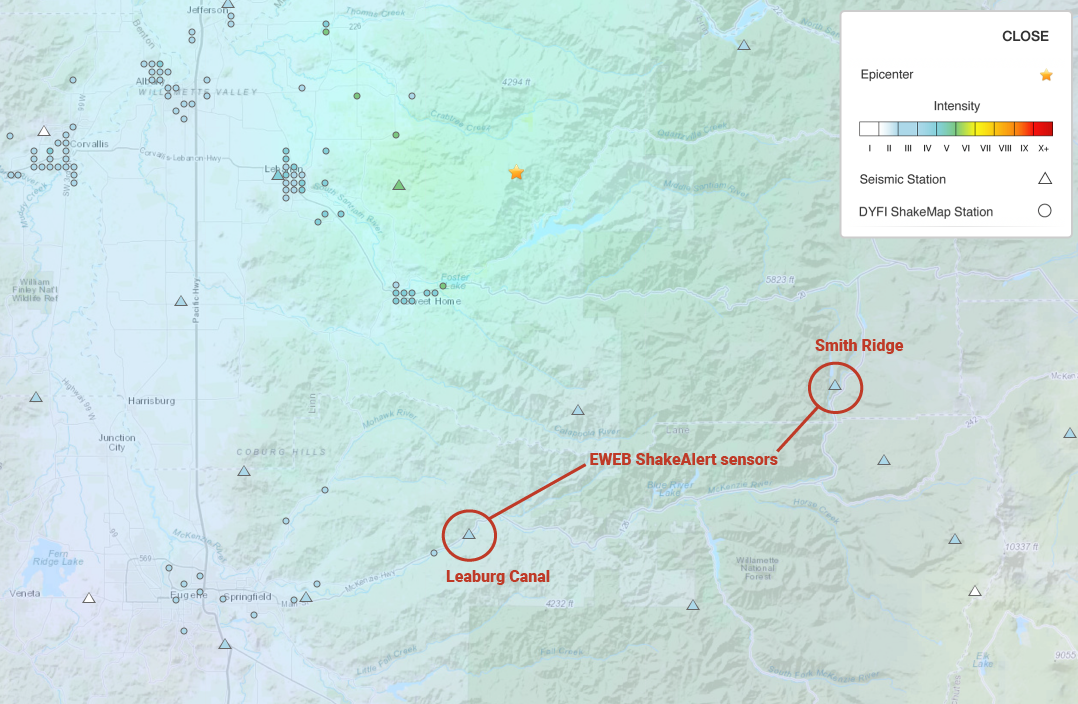Related News
Related News
-
Sustainability Snapshot - Celebrating Energy Efficiency Projects in the Community
Sustainability Snapshops highlight impactful projects completed by EWEB's Customer Solutions department, as a way to celebrate the meaningful work happening behind the scenes.
Find Out More -
McKenzie Valley electric service territory realignment study reaches key milestone
EWEB Commissioners approved a resolution authorizing the General Manager to negotiate and execute agreements with Lane Electric Cooperative regarding a potential realignment of electric service territory in the McKenzie Valley at the Board’s December meeting.
Find Out More -
EWEB secures $2.5 billion of reliable, affordable, carbon-free energy for customers
The new contract with EWEB’s largest energy supplier, the Bonneville Power Administration, forms the foundation of a diverse energy portfolio.
Find Out More -
Women in STEM: Meet the Hydro Project Engineer Building Habitat for Salmon
EWEB Engineer Associate Val Chang found her way to the McKenzie River from Los Angeles, inspired by heritage trips to the waters of Taiwan and key mentors along the way.
Find Out More -
Public Power Week Poster Contest Winners 2025
The results are in! View the winning posters from EWEB's 2025 Public Power Week Poster Contest.
Find Out More -
EWEB Hometown Heroes compete internationally
Out of 290 teams from 14 different countries, EWEB's Lineman Rodeo team places in the top third of competitors.
Find Out More -
EWEB's Halloween Truck-or-Treat is a huge success
Community members are accustomed to spotting EWEB trucks around Eugene streets and neighborhoods. But last week, those familiar vehicles looked a little different. At EWEB's second annual Truck-or-Treat Customer and Crew Appreciation Event, our fleet transformed into a festive Halloween spectacle.
Find Out More -
Let's Talk Turkey. Is your family ready for winter?
We're heading into the holidays, but that also means snow, ice, and not-so-nice weather might be in the forecast. Here are some tips to prepare in advance.
Find Out More -
Vote for your favorite Public Power Week Posters
The top five submittals will receive awards. Help us pick the winners.
Find Out More -
EWEB Hosts Annual Spill Drill to Protect McKenzie River
EWEB led emergency responders in its annual “spill drill” on the McKenzie River on Wednesday, Oct. 15, at the Trail Bridge Campground.
Find Out More -
Electric Projects underway in North & South Eugene
Underground lines and disaster-resilient power poles are part of EWEB’s infrastructure upgrade near Eugene’s largest natural resource area.
Find Out More -
EWEB general manager to retire in 2026
EWEB launches nationwide search for next leader to continue the progress of the last decade and ensure a smooth transition.
Find Out More -
The Bonneville Power Administration Rate Change and Your EWEB Bill
BPA’s finalized rate increase is smaller than projected, and EWEB’s pass-through adjustment effective October 1, 2025 will now be 2.7% for residential customers—down from the anticipated 4%.
Find Out More -
Quartz Creek: Setting the Stage for Floodplain Restoration
The project resets the floodplain along 1.8 miles of a formerly channelized creek to improve water quality, fish habitat and natural disaster resiliency.
Find Out More -
You can’t predict the next disaster, but you can prepare
The earthquake lasted less than a minute. But now the power’s out. The tap runs dry. Cell service is spotty. Would you be ready?
Find Out More - Show More
EWEB and ShakeAlert monitor earthquake effects on hydropower facilities
October 20, 2022

Today EWEB joined over 44 million organizations across the nation in the Great ShakeOut – the world’s largest earthquake drill.
The event is an important reminder of what to do during an earthquake: Drop, Cover, and Hold On. But getting through an actual earthquake is only one step of many to be prepared for one.
EWEB is preparing for earthquakes by upgrading our facilities to modern seismic standards, building emergency water stations in case an earthquake disrupts our ability to supply water for the people of Eugene, and partnering with the ShakeAlert program to monitor our hydropower facilities at Leaburg and Carmen-Smith.
Working with the Oregon Hazards Lab, EWEB installed seismometers at the Leaburg Canal and on Smith Ridge above the Smith Reservoir. These sensors measure acceleration from seismic events, allowing EWEB to contribute information to the Pacific Northwest Seismic Network (PNSN), the foundation of the ShakeAlert early warning system. EWEB also benefits from sensors installed throughout the region, receiving advance ShakeAlert warnings of seismic events that could impact our facilities.
At the Leaburg Canal, the seismic sensor incorporates an accelerometer which sends local ground motion data to PNSN’s analytic servers. These servers use the data to instantly determine the epicenter location and magnitude of the seismic event. Potentially damaging events then trigger the release of ShakeAlert warnings. EWEB is developing control systems capable of using these ShakeAlert warnings to take automatic protective action, such as opening or closing gates to reduce water levels in our water retaining canal facilities. ShakeAlert also sends alerts based on ground motion data from the broader regional network at large in a predictive manner to help EWEB operators understand the implications of a far-away earthquake on EWEB facilities.
This month’s 4.4 earthquake near the Green Peter Reservoir north of Sweet Home is a good example of how ShakeAlert helps EWEB’s generation facilities. Within seconds (8.8 seconds, to be exact), the ShakeAlert system sent our operators messages estimating how that earthquake’s shaking would propagate across the Calapooia watershed on to the McKenzie Valley to affect our facilities.
According to the ShakeAlert report, Eugene and our upriver facilities would have felt shaking ten seconds after the earthquake began and at only a two on the Modified Mercalli Intensity Scale (MMI) – a descriptive indicator of earthquake intensity based on peoples’ felt experiences of shaking during the event. An MMI of two is “Weak,” and “Felt only by a few persons at rest, especially on upper floors of buildings.”
“Our local emergency managers called EWEB to check in on the status of our facilities,” said EWEB Generation Engineering Supervisor Mark Zinniker. “The ShakeAlert contour map was really helpful to show them that the amount of shaking was not significant to our facilities.”

Members of the public can sign up for ShakeAlert notifications, too, for events above a 4.5 magnitude on the Richtor scale. ShakeAlert notifications are also built into the Android OS.
“We monitored the situation and ShakeAlert did exactly what we wanted it to do, but this event did not meet the threshold for public communication, which is 4.5 magnitude and above,” said Robert de Groot, ShakeAlert Coordinator for Communication, Education, Outreach and Technical Management.
With today’s Great ShakeOut drill as an inspiration, it’s a great opportunity to talk about earthquake preparedness with your family. Do you know the Seven Steps to Earthquake Safety? Take a moment to secure your space, plan to be safe, organize supplies, and minimize financial hardships before the next big one shakes things up for real. EWEB’s Pledge to Prepare program is a good starting place for all kinds of emergencies.

